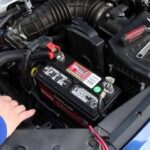Electric cars, known formally as battery electric vehicles (BEVs) or all-electric vehicles, represent a significant shift in automotive technology. Unlike traditional gasoline-powered vehicles, electric cars are propelled by an electric motor rather than an internal combustion engine. At the heart of this system is a large traction battery pack, which supplies power to the electric motor. To replenish this energy, BEVs must be connected to an external electricity source, either a standard wall outlet or dedicated electric vehicle supply equipment (EVSE). A key advantage of electric cars is their zero-emission operation – they produce no tailpipe exhaust and eliminate the need for conventional fuel system components like fuel pumps, lines, and tanks.
Key Components of an Electric Vehicle Explained
To understand how electric cars operate, it’s crucial to examine their core components:
Auxiliary Battery: Similar to a conventional car, an electric vehicle includes an auxiliary battery. This battery provides the necessary electricity to power the car’s accessories, such as lighting, infotainment systems, and other electronic controls.
Charge Port: The charge port serves as the gateway for energy replenishment. It allows the electric car to connect to an external power source, enabling the charging of the main traction battery pack.
DC/DC Converter: The DC/DC converter plays a vital role in managing power distribution. It efficiently converts the high-voltage DC power from the traction battery pack to a lower voltage level. This lower voltage DC power is essential for running the vehicle’s accessories and for recharging the auxiliary battery.
Electric Traction Motor: This is the driving force behind an electric car. Powered by the traction battery pack, the electric traction motor converts electrical energy into mechanical energy, which propels the vehicle’s wheels. Some advanced designs integrate motor generators that handle both propulsion and regenerative braking functions.
Onboard Charger: The onboard charger is responsible for managing the charging process. It takes the incoming AC electricity from the charge port and converts it into DC power, which is suitable for charging the traction battery. Crucially, it also communicates with the charging equipment and continuously monitors critical battery parameters such as voltage, current, temperature, and state of charge to ensure safe and efficient charging.
Power Electronics Controller: This unit acts as the brain of the electric powertrain. The power electronics controller expertly manages the flow of electrical energy from the traction battery. It precisely controls the speed of the electric traction motor and the torque output, allowing for responsive and efficient driving.
Thermal Management System: Maintaining optimal temperature is critical for performance and longevity. The thermal system (cooling system) ensures that the engine, electric motor, power electronics, and other key components operate within their ideal temperature ranges, preventing overheating or damage.
Traction Battery Pack: The traction battery pack is the energy reservoir of an electric car. It stores a significant amount of electricity, which is then used to power the electric traction motor and drive the vehicle. The capacity of this battery pack largely determines the vehicle’s driving range.
Electric Transmission: The electric transmission system is simpler than in conventional cars. It efficiently transfers the mechanical power generated by the electric traction motor to the wheels, enabling the vehicle to move.
